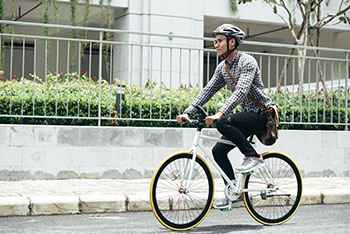
Bicycle Safety
With rising gas prices, more and more people are using bicycles to commute in urban areas, and cycling remains a popular form of exercise and leisure. While traveling on the roadway, cycles are considered vehicles and must adhere to motorized vehicles’ same rights and responsibilities. When a crash occurs between a vehicle and a bike, it is the cyclist who runs the risk of injury. For this reason, it is essential for a cyclist to know the rules and be familiar with ways to stay safe.
Helmets
A cyclist’s first line of defense against injury is a helmet. However, helmet size varies across manufacturers, so you should take the time to ensure your helmet fits correctly. A list of sizes by manufacture can be found at https://helmets.org/, and fitting tips can be found at https://www.nhtsa.gov/sites/nhtsa.gov/files/8019_fitting-a-helmet.pdf.
Decreasing Crash Risks
The main types of crashes experienced by cyclists are commonly occurring falls and more severe crashes involving automobiles. Most cyclist deaths from crashes occur between 6 p.m. and 9 p.m., and 75% of all crashes occur in urban areas. Males are slightly more likely to be involved in crashes, and in 2017, alcohol had a role in 37% of all fatal bicycle crashes. The following steps can help you prepare for a safe outing:
- Ride a bike that fits you
- Ride a completely operational bike
- Wear protective equipment and items to make you more visible such as reflective (night riding) or bright (day riding) clothing
- Tucking your shoelaces into your pants legs
- Plan a route to avoid high traffic areas and areas with high-speed limits
Ride Defensively – be focused and alert to your surroundings and anticipate other’s moves.
- Drive with the flow of traffic
- Obey all street signs and signals
- Assume the other person does not see you
- Look ahead for hazards or situations to avoid, such as toys, pebbles, potholes, grates and train tracks
- Do no text, listen to music or perform any other distracting activity
Ride Predictably – ride where you are expected to be seen, signal, and look over your shoulder before changing lanes or turning. Avoid riding on the sidewalk, but if you must ride on the sidewalk, do the following:
- Check your state laws and county ordinances
- Watch for walkers
- Pass pedestrians with care
- Ride the same direction as traffic
- Slow and look for traffic before crossing the street, and be prepared to stop in observance of pedestrian signals
- Watch for cars backing out of driveways or making turns
It is never too late to improve your riding skills. Before riding in traffic, practice in a safe environment. You can even take biking classes through schools, recreation departments, local bike shops, and advocacy groups.
For Drivers
Share the road. Yield to cyclists as you would any other motorist, and do not underestimate bike speeds. Look for cyclists when making a right-hand turn on red and obey speed limits. Give cyclists plenty of room and do not pass too closely.





